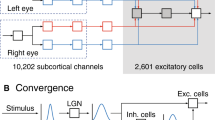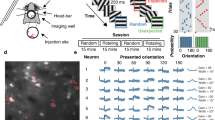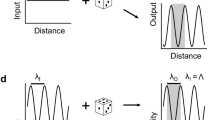Abstract
Neurons in the primary visual cortex are highly selective for stimulus orientation, whereas their thalamic inputs are not. Much controversy has been focused on the mechanism by which cortical orientation selectivity arises. Although an increasing amount of evidence supports a linear model in which orientation selectivity is conferred upon visual cortical cells by the alignment of the receptive fields of their thalamic inputs, the controversy has recently been rekindled with the suggestion that late cortical input—delayed by multiple synapses—could lead to sharpening of orientation selectivity over time. Here we used intracellular recordings in vivo to examine temporal properties of the orientation-selective response to flashed gratings. Bayesian parameter estimation demonstrated that both preferred orientation and tuning width were stable throughout the response to a single stimulus.
This is a preview of subscription content, access via your institution
Access options
Subscribe to this journal
Receive 12 print issues and online access
$259.00 per year
only $21.58 per issue
Buy this article
- Purchase on SpringerLink
- Instant access to full article PDF
Prices may be subject to local taxes which are calculated during checkout





Similar content being viewed by others
References
Hubel, D. H. & Wiesel, T. N. Receptive fields, binocular interaction and functional architecture of cat's visual cortex. J. Physiol. (Lond.) 160, 106–154 (1962).
Ben-Yishai, R., Bar-Or, R. L. & Sompolinsky, H. Theory of orientation tuning in visual cortex. Proc. Natl. Acad. Sci. USA 92, 3844–3848 (1995).
Somers, D. C., Nelson, S. B. & Sur, M. An emergent model of orientation selectivity in cat visual cortical simple cells. J. Neurosci. 15, 5448–5465 (1995).
Ferster, D. & Miller, K. D. Neural mechanisms of orientation selectivity in the visual cortex. Annu. Rev. Neurosci. 23, 441–471 (2000).
Sillito, A. The contribution of inhibitory mechanisms to the receptive field properties of neurones in the striate cortex of the cat. J. Physiol. (Lond.) 250, 287–304 (1975).
Eysel, U. T., Crook, J. M. & Machemer, H. F. GABA-induced remote inactivation reveals cross-orientation inhibition in the cat striate cortex. Exp. Brain Res. 80, 626–630 (1990).
Hata, Y., Tsumoto, T., Sato, H., Hagihara, K. & Tamura, H. Inhibition contributes to orientation selectivity in visual cortex of cat. Nature 335, 815–817 (1988).
Gilbert, C. D. & Wiesel, T. N. Columnar specificity of intrinsic horizontal and corticocortical connections in cat visual cortex. J. Neurosci. 9, 2432–2442 (1989).
Crook, J. M. & Eysel, U. T. GABA-induced inactivation of functionally characterized sites in cat visual cortex (area 18): effects on orientation tuning. J. Neurosci. 12, 1816–1825 (1992).
Krnjevic, K., Randic, M. & Straughan, D. W. An inhibitory process in the cerebral cortex. J. Physiol. (Lond.) 184, 16–48 (1966).
Ferster, D. & Lindström, S. An intracellular analysis of geniculo-cortical connectivity in area 17 of the cat. J. Physiol. (Lond.) 342, 181–215 (1983).
Hirsch, J. & Gilbert, C. D. Synaptic physiology of horizontal connections in the cat's visual cortex. J. Neurosci. 11, 1800–1809 (1991).
Douglas, R. J. & Martin, K. A. C. A functional microcircuit for cat visual cortex. J. Physiol. (Lond.) 440, 735–769 (1991).
Ringach, D. L., Hawken, M. J. & Shapley, R. Dynamics of orientation tuning in macaque primary visual cortex. Nature 387, 281–284 (1997).
Celebrini, S., Thorpe, S., Trotter, Y. & Imbert, M. Dynamics of orientation coding in area V1 of the awake primate. Vis. Neurosci. 10, 811–825 (1993).
Volgushev, M., Vidyasagar, T. R. & Pei, X. Dynamics of the orientation tuning of postsynaptic potentials in the cat visual cortex. Vis. Neurosci. 12, 621–638 (1995).
Bonds, A. B. Role of inhibition in the specification of orientation selectivity of cells in the cat striate cortex. Vis. Neurosci. 2, 41–55 (1989).
Heeger, D. J. Normalization of cell responses in cat striate cortex. Vis. Neurosci. 9, 181–197 (1992).
DeAngelis, G. C., Robson, J. G., Ohzawa, I. & Freeman, R. D. Organization of suppression in receptive fields of neurons in cat visual cortex. J. Neurophysiol. 68, 144–163 (1992).
Crair, M. C., Ruthazer, E. S., Gillespie, D. C. & Stryker, M. P. Relationship between the ocular dominance and orientation maps in visual cortex of monocularly deprived cats. Neuron 19, 307–318 (1997).
Gardner, J. L., Anzai, A., Ohzawa, I. & Freeman, R. D. Linear and nonlinear contributions to orientation tuning of simple cells in the cat's striate cortex. Vis. Neurosci. 16, 1115–1121 (1999).
Carandini, M. & Ferster, D. Membrane potential and firing rate in cat primary visual cortex. J. Neurosci. 20, 470–484 (2000).
Swindale, N. V. Orientation tuning curves: empirical description and estimation of parameters. Biol. Cybern. 78, 45–56 (1998).
Gilbert, C. D. & Wiesel, T. N. The influence of contextual stimuli on the orientation selectivity of cells in primary visual cortex of the cat. Vision Res. 30, 1689–1701 (1990).
Volgushev, M., Pernberg, J. & Eysel, U. T. Comparison of the selectivity of postsynaptic potentials and spike responses in cat visual cortex. Eur. J. Neurosci. 12, 257–263 (2000).
Freeman, T. C. B., Durand, S., Kiper, D. C. & Carandini, M. Probing the source of cross-orientation suppression in the primary visual cortex. Invest. Ophthalmol. Vis. Sci. (in press).
Ferster, D. Orientation selectivity of synaptic potentials in neurons of cat primary visual cortex. J. Neurosci. 6, 1284–1301 (1986).
Sivia, D. S. Data Analysis: A Bayesian Tutorial (Oxford, New York, 1996).
Acknowledgements
The authors thank S. Solla, D. Goldreich and M. Kvale for helpful discussions, and S. Solla, K. Miller, M. Stryker and D. Sharon for comments on the manuscript. This work was supported by US National Institutes of Health grant RO1EYO4726 and the Human Frontiers Science Program.
Author information
Authors and Affiliations
Corresponding author
Rights and permissions
About this article
Cite this article
Gillespie, D., Lampl, I., Anderson, J. et al. Dynamics of the orientation-tuned membrane potential response in cat primary visual cortex. Nat Neurosci 4, 1014–1019 (2001). https://doi.org/10.1038/nn731
Received:
Accepted:
Published:
Issue date:
DOI: https://doi.org/10.1038/nn731
This article is cited by
-
Linearization of excitatory synaptic integration at no extra cost
Journal of Computational Neuroscience (2018)
-
Mean-field analysis of orientation selectivity in inhibition-dominated networks of spiking neurons
SpringerPlus (2014)
-
Development of spatial coarse-to-fine processing in the visual pathway
Journal of Computational Neuroscience (2014)
-
Coding of stimulus sequences by population responses in visual cortex
Nature Neuroscience (2009)
-
Theoretical analysis of reverse-time correlation for idealized orientation tuning dynamics
Journal of Computational Neuroscience (2008)



